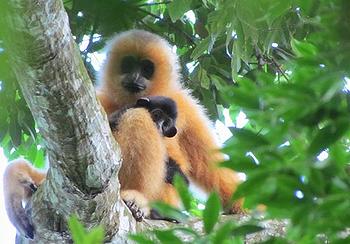
JEJU ISLAND, South Korea, September 11, 2012 (ENS) – The 100 species at greatest risk of extinction were named for the first time today at the World Conservation Congress being held on Jeju Island by the International Union for Conservation of Nature, IUCN.
Many of these species are not useful to humans for food or medicine or any reason other than their participation in the web of life on Earth. The scientists who compiled the list say humans must choose whether to save them for their own sake or allow them to quietly disappear.

More than 8,000 scientists from the IUCN Species Survival Commission identified the 100 most threatened animals, plants and fungi on the planet.
Their report, the new book “Priceless or Worthless?,” was presented at the World Conservation Congress today by the Zoological Society of London and the IUCN, which maintains the authoritative Red List of Threatened Species.
Today the names of these species are seldom heard – Angel shark, Suicide palm, Chinese crested tern, Hainan gibbon, Tonkin snub-nosed monkey, Silky sifaka, Rosa arabica, Boni giant sengi – even when a species was once so common that the word forms part of its name as in the Common sawfish, which is on the list of the 100 most Critically Endangered species.
“All the species listed are unique and irreplaceable. If they vanish, no amount of money can bring them back,” says Ellen Butcher of the Zoological Society of London, co-author of the report. “However, if we take immediate action we can give them a fighting chance for survival. But this requires society to support the moral and ethical position that all species have an inherent right to exist.”
Professor Jonathan Baillie, ZSL’s director of conservation, the report’s other co-author said, “The donor community and conservation movement are leaning increasingly towards a ‘what can nature do for us’ approach, where species and wild habitats are valued and prioritised according to the services they provide for people.”
“This has made it increasingly difficult for conservationists to protect the most threatened species on the planet,” said Baillie. “We have an important moral and ethical decision to make: do these species have a right to survive or do we have a right to drive them to extinction?”
In the book, Prince William, the Duke of Cambridge, says, “This book does not merely tell us which species are most endangered, it shows us how we can save them. It challenges us to commit to safeguarding our priceless natural heritage for future generations.”
Some of the mammals on this Critically Endangered list are:

Javan rhinoceros, Rhinoceros sondaicus: Once the most widespread of Asian rhinoceroses, the species is now the rarest large mammal on Earth, due to poaching for its horn, prized in traditional medicine. One horn can bring up to US$30,000 on the black market. As few as 40 individuals live in Ujung Kulon National Park at the western tip of Java in Indonesia in the one wild population that still remains. A second population in Vietnam’s Cat Tien National Park was confirmed as extinct in 2011.
Sumatran rhino, Dicerorhinus sumatrensis: Fewer than 250 mature individuals still cling to survival in Sabah, Sarawak and Peninsular Malaysia and in Kalimantan and Sumatra, Indonesia. They are poached for their horns used in traditional medicine. Saving this species would take expansion and reinforcement of anti-poaching programs and continuation of captive breeding efforts.
Saola, Pseudoryx nghetinhensis: A mammal known as the Asian unicorn for its rarity, thisrelative of cows and goats is found only in the Annamite mountains of Vietnam and Laos where only a few tens of individuals are believed to exist. The saola has yet to be seen in the wild by a scientist.
Pygmy three-toed sloth, Bradypus pygmaeus: Just 500 of these tiny sloths live on Escudo Island off the coast of Panama.
Red-crested tree rat, Santamartamys rufodorsalis: Classed as Vulnerable to extinction as recently as 1996, this species now is known from just two specimens found in the deforested Sierra Nevada de Santa Marta mountains of northeast Colombia. Copyright Lizzie Noble Fundacion ProAves.JPG
Nelson’s small-eared shrew, Cryptotis nelsoni: This species was discovered in 1894 on the slopes of the San Martín volcano in Veracruz, Mexico. The species was not recorded again and was thought to be extinct until it was rediscovered in the same area in 2004. Copyright Lazaro Guevara.jpg
Hirola, Hunter’s antelope, Beatragus hunteri: In 1979, there were some 16,000 of these animals in Kenya, but by 1985 after a drought there were at most 2,000 left in Kenya. Somalia had about 2,000 Hirola in 1979, but has few, if any, today. Tim Wacher ZSL.JPG
Northern Muriqui, wooly spider monkey, Brachyteles hypoxanthus: Fewer than 1,000 of these primates still remain in southeastern Brazil’s Atlantic forest.

The list of 100 most endangered species also spotlights birds, frogs, snakes, fish, tortoises, butterflies and other insects, as well as plants and fungi.
The scientists who nominated these species to the list say their declines have mainly been caused by humans, but in almost all cases their extinction can still be avoided if conservation efforts are specifically focused on saving them.
They point to conservation actions that have saved such Critically Endangered species as Przewalski’s Horse, Equus ferus, and the Humpback whale, Megaptera novaeangliae.
Professor Baillie said, “If we believe these species are priceless it is time for the conservation community, government and industry to step up to the plate and show future generations that we value all life.”
In the book, Dr. Russell Mittermeier, president of Conservation International, speaks for saving these species as a basis for saving the entire planet. “Conservation began with a focus on species, especially those in danger of extinction,” he says, “and a major species focus needs to continue as a central element in all efforts to ensure the long-term viability of our living planet.”
Copyright Environment News Service (ENS) 2012. All rights reserved.
